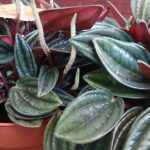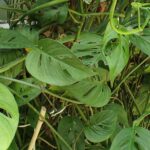Hoya Australis is a glorious climbing plant that will bring joy to your household for beginners and expert gardeners alike.
A moderately vigorous climber, Hoya Australis has thick, shiny wax like leaves and stunning flower clusters with a distinctive highly fragrant perfume.
Table of Contents
Profile
Hoya Australis is a simply gorgeous plant and is generally considered one of the best houseplants due to its extremely hardy nature.
Hoya Australis produces spectacular sprays of white, star-like flower clusters in summer, which hang down from the plant from stem-like peduncles and spurs.
It is important to note that flowers come from the same spurs year after year, so ensure you allow the flowers die and drop off naturally rather than cutting them off. Hoya Australis likes to climb, and so is ideal to train over a trellis or climbing pole.
Character
The best thing about Hoya Australis is its extremely forgiving nature; you would be hard pressed to find an easier plant to care for! This makes it a great plant for beginner gardeners.
It’s generally not a fast-growing plant, but the upside of this is that it enjoys being pot bound so there’s no need to change pot sizes too often.
How To Care For Hoya Australis
Water
Like most house plants, Hoya Australis’s biggest enemy is overwatering. Hoyas have low water requirements, and you should generally wait for the soil to dry out before watering thoroughly.
As a rule of thumb (or finger!), you can insert your finger into the soil to check for water requirements. If the top two inches of soil are dry – you can safely water your hoya.
Hoya Australis can store water in its leaves so another way to tell if it’s time to water is just by looking at your plant. If the leaves are crinkly or bend easily, it’s time to water. Give it a nice drink and the leaves will plump out again nicely.
Remember that as a basic rule it is always better to underwater than overwater houseplants.
Soil
Hoya Australis thrives on an airy, well-draining potting mix which reduces the chance of overwatering or root rot. An idea mix would incorporate orchid bark and coarse perlite which prevent the soil from compacting over time.
Hoya hates having wet feet, which will cause the roots to rot, so whatever mix you chose, ensure it’s a well-draining one.
Light
While Hoya Australis can and will grow in low light areas, for those stunning flowers your Hoya needs bright, dappled, or indirect sunlight.
Morning sun is ideal, as well as filtered afternoon sun, but harsh direct sunlight will burn Hoya’s leaves. Take care when placing in windows, as glass can act as a magnifier and will quickly burn the plant.
Temperature
Hoya Australis is a tropical plant, and it flourishes in a temperature range of 60 – 75 degrees Fahrenheit, or 18 – 24 degrees Celsius. It also enjoys a humid environment, although will tolerate areas with lower humidity.
If you are keen, you could consider creating your own humid microclimate by placing your Hoya plant on or near dishes of water (if you place it on a dish, make sure you place gravel in the dish so the water doesn’t soak into the Hoya pot).
For those of you who are looking to invest a little more into your plant care, you could consider the purchase of a humidifier.
Propagation
Hoya Australis is child’s play to propagate! It is generally best to do so in spring or summer, during the growing season, when roots will develop more quickly than in winter. Hoya cuttings can easily be propagated in soil or in water.
If you choose to propagate with stem cuttings in water:
- Snip off a stem of around 10 centimeters in length. Make sure your cutting has at least two leaves and at least one node. A node is a sort of join in the stem, and this is a point where new growth can come from.
- Pop the stem into water, ensuring that the leaves are well above the water line. If you like, you can add a few drops of rooting hormone to the water.
- Be patient! The stem will develop roots in around two weeks.
- When the roots are around 5cm in length, transfer to soil.
The method for propagating stem cuttings in soil is basically the same for water, except of course you use soil instead.
Make sure the soil is kept moist, but not wet, while the roots are forming. When propagating in soil it is important not to overwater, as this will cause the tiny new roots to rot.
Hoyas are epiphytic, meaning they grow on other plants like rainforest trees, and as such they have very small roots. When choosing a pot, go smaller rather than big – too large a container will hold too much water for the roots to absorb, and could lead to root rot.
Fertilizer
If it’s flowers you are after (and Hoya flowers are worth the chase!), feed your Hoya Australis. Use with a liquid fertilizer around once a month in the period right before flowering (spring) and continue until your Hoya stops flowering.
Pruning
When pruning, bear in mind that flowers will grow from the same spurs each year, so if you cut them off you’ll lose those flowers for the next year.
Having said that, giving your Hoya a good prune will result in loads of new growth points, a fuller plant and more flowers in the long run.
To prune your Hoya:
- Cut away dead or damaged leaves at the stem.
- Remove leggy stems.
- Do not remove spent flowers or trim the spurs they grow from IF you want flowers to grow from those points the following year.
- Do trim plants to just above a node – this will encourage fuller growth and side shoots.
- Longer stems can either be pruned back or wound around a trellis or pole – it’s your plant so do whatever looks pleasing to your eye!
Pests and Diseases
Hoyas are generally pest resistant, but like all plants can succumb to infestation if the conditions are right.
Aphids, mealybugs, scale, and spider mites are the main offenders, and can be treated with commercial products specifically designed to eradicate them. Home remedies for these pests include:
- Manually scraping off aphids or mealybugs, which can be done with a cotton swab soaked in rubbing alcohol. This method can also be applied to scale. The alcohol will kill the bugs, which you can then pick off manually.
- Blasting off spider mites and aphids with water.
Photo by Claud Richmond on Unsplash



